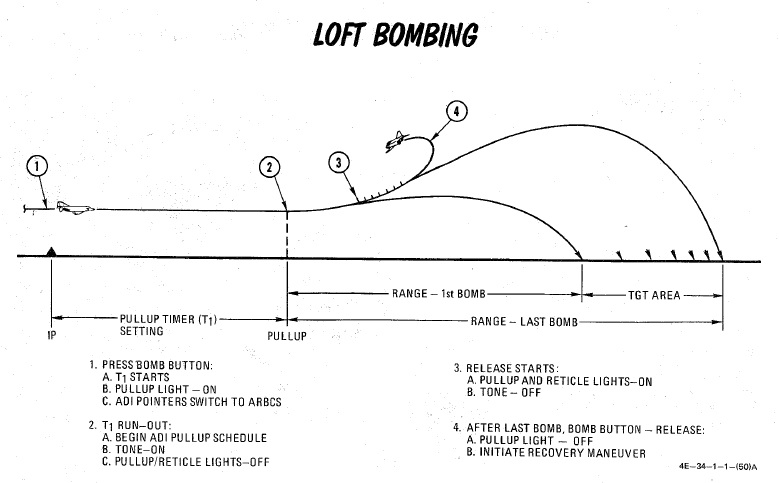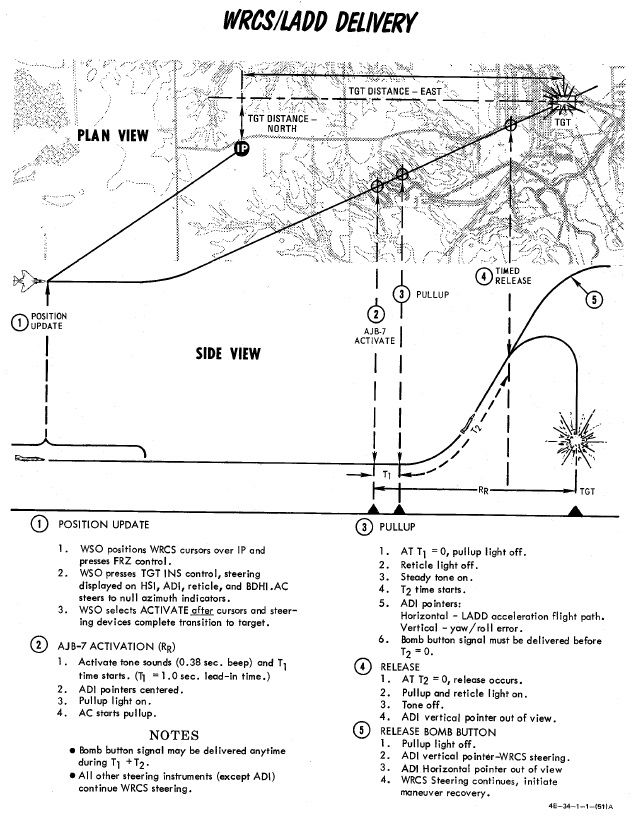Lofting and Tossing
The Phantom supports a variety of ways to loft and toss bombs on targets with minimum expose to ground fire while sacrificing accuracy.
These modes are mostly designed to be used with nuclear weapons, but can also be used effectively with conventional bombs when employing a high amount of ammunition while attacking a larger area target.
They are categorized into either lofting or tossing modes.
| Category | Modes | Release Angle |
|---|---|---|
| Lofting | LOFT, T LAD | below 90° |
| Tossing | O/S, INST O/S | above 90° |
The benefit of lofting is that target flyover can be avoided, greatly minimizing the risk of getting attacked. Weapons can be dispensed from great distances, allowing the aircraft to turn around before entering the dangerous zone.
If target flyover is possible, tossing modes allow for more accuracy by designating the target visually by initiating the maneuver over the target area. The advantage compared to other visual release modes is that the time until weapon impact is greatly increased, allowing the aircraft to gain some distance before impact. This is crucial when employing nuclear weapons.
LOFT
As the name entails, the aircraft transitions from a low altitude to a higher one in a pull-up, thus lofting the released munitions at a pre-calculated point that reaches the target.
The mode revolves around computing and setting a pull-up timer based on the desired release parameters, such as altitude, speed and loft angle.
The pilot flies to the reference point, holds the bomb button and starts initiating the pull-up maneuver the moment the aircraft gives the pull-up cue. Weapons automatically release when reaching the setup loft angle.

Procedure - LOFT
Planning for a loft attack requires a known target location, so that distances for the IP and respective bomb ranges can be calculated. The ballistics tables are references to determine delivery pattern and pull-up-to-target range.
With this information, the number of bombs can be decided, which determines the spread, and knowing the pull-up to target range - the pull-up point distance to the IP can be chosen.
As the path from IP to pull-up is flown at a constant speed, this can then be used to determined time from said distance for pull-up Timer entry. And with the ballistic table reference for the LOW angle, the profile is set.
💡 The Bombing Calculator Tool can be used to compute the proper value for the Pull-Up Timer.
Upon entry to the target area, the pilot flies the intended course to the IP, and once over, presses and holds the bomb release button to initiate the run. Flying direct or crabbed to the pull-up point, the pilot maintains the bomb release button in the down position, and holds it until the desired munitions have released.
In LOFT mode, the ARBCS programs for a 4 G pull-up schedule, and will automatically release the selected munitions once the bombing run is initiated, timer runout has occurred, and pre-set LOW pitch (gyro) angle is achieved.
At the initiation of the bomb run, upon pressing the bomb button, the ARBCS overrides any other navigational guidance provided on the ADI and assumes command of the pointers to show deviation relative to the programmed attack profile. The vertical pointer offsets in the direction requiring yaw input to maintain target alignment. On approach to the loft point, the horizontal needle shows deviation from a 1.0 G flight path.
When the pull-up timer completes signaling the 4 G pull-up, deviation of the horizontal needle is relative to the desired constant 4 G pull, with the initial drift representing achieving 4 G of load in two seconds. Maintaining the horizontal needle centered means the pilot has increased and held G at the proper rate for maximum accuracy. Control of the ADI by the AN/AJB-7 is maintained until the pilot releases the bomb button after the last desired munition is released.
Timed Low Angle Drogue Delivery - T LAD(D)
Conceived as a delivery method for tactical nuclear bombs, Timed Low Angle Drogue Delivery is a variation of LOFT to maximize the time to impact by lofting a bomb with drogue at maximum distance to the target.
The mode performs a low altitude ingress, transitioning through a 3.5 G pull-up into a 45 degree climb profile that allows for a lofted release of a weapon at the top of the climb, allowing an escape attempt as the munition's deployed drogue slows the decent to the target. While originally designed with nuclear intent, the method provides yet another option for accurate bomb delivery with a high, or high to low, escape option for appropriate targets.

Procedure - T LAD(D)
Planning of the T LADD engagement begins in the bombing tables, determining the correct entry altitude and airspeed for the selected weapon, as well as the resulting altitude gain and time from pull up initiation to release - which will be used as the Release control timer value, as well as the distance downrange this climb maneuver will take the aircraft.
Using this range as a baseline, an appropriate approach angle is determined, and a suitable IP waypoint is chosen. The distance between the IP and the pull-up point is evaluated against the planned profile speed, which provides another time entry - this will be the pull-up timer value.
💡 Timer values can be obtained using the Bombing Calculator Tool.
The attack is performed by flying over the IP along the desired intercept heading to the target at the correct speed and altitude, and actuating the bomb release button upon flyover of said IP, holding it down throughout the maneuver.
This begins the pull-up timer. The ADI needles will center, then show deviation against the initial heading course - vertical being roll, horizontal being level to maintain current altitude.
At timeout of the pull-up timer, a pull-up warning tone will be provided, and the pull-up Lamp will illuminate; subsequently, the Release timer will begin its count, the horizontal ADI needle will transition into show deviation from the intended 3.5 G pitch angle, and then stabilize once 45 degrees nose up pitch is attained. Proper timing and loading of the 3.5 G pull-up will maintain the needle centered.
At timeout of the Release timer, the programmed munitions will release, the pull-up light will turn off, and the ADI needles will be stowed. Once the last round is ejected, the bomb release button can be released, and the desired escape maneuver performed.
Timed Over the Shoulder - O/S
Similar to LOFT, this mode allows deploying weapons based on a pull-up timer that represents the distance from IP to target.
Weapons are released during a pull-up maneuver when reaching the setup release angle. In this mode, release angles are beyond 90°; effectively tossing the weapon over the shoulder, in contrast to lofting it ahead.
The mode revolves around computing and setting a pull-up timer based on the desired release parameters, such as altitude, speed and toss angle.
The pilot then flies to the reference point, holds the bomb button and starts initiating the pull-up maneuver the moment the aircraft gives the pull-up cue. Weapons automatically release when reaching the setup toss angle.
Procedure - O/S
Setup of the LABS system requires time (calculated using the known distance from the set IP to the target flyover point and the intended airspeed) and calculated release angle for the resulting airspeed and munition, which is entered into the High Angle setting; this value must be in excess of 90 degrees, and the Low Angle and secondary timer settings can be left at any value.
💡 The Pull-Up Timer value can be computed using the Bombing Calculator Tool.
Flying the appropriate heading at the correct speed guarantees target flyover, and upon timer runout an audible tone will be heard to initiate pull-up, along with the Pull-Up Lamp illuminating. This timing action is initiated by pressing the bomb button over the IP, and holding it throughout the attack run.
Like LOFT mode, the pull-up signal indications will also trigger the horizontal and vertical pointers on the ADI to display appropriate pitch and angle indications to maintain proper aircraft orientation for accurate release point entry, and the target pull rate is 4 G. The guidance drives the attacking aircraft through an Immelmann, and the bombs will release at the entered High Angle value.
Maximum accuracy is achieved through maintaining a centered horizontal needle during the entire bombing run, and like LOFT, the ADI reverts back to the previous function once the bomb button is released after the last intended munition for the run has been dropped.
Instantaneous Over the Shoulder - INST O/S
Further, derived from the Timed O/S mode, Instantaneous Over the Shoulder bombing provides the same combined attack/escape profile as the former against targets of opportunity.
In this mode, setting up an IP and a timer are not needed. Instead, the target is designated by pressing the Bomb Button once over the target and executing the pull-up maneuver shortly after.
Procedure - INST O/S
Similar to Timed O/S, a desired release angle over 90° has to be configured.
Once the aircraft is directly over the target, the pilot presses and holds the bomb release button and initiates the 4 G wings level pull up into the Immelmann maneuver.
The LABS computer performs the same ADI display overrides as Loft and Timed O/S, placing the horizontal director needle at the pitch appropriate for a 4 G pull, and the vertical director displays deviation to maintain proper angle of bank through the maneuver.
Upon reaching the necessary angle of pitch, the munitions separation begins, and the bomb release button can be released once all desired rounds have been ejected from the aircraft, thus resetting the display of the ADI.